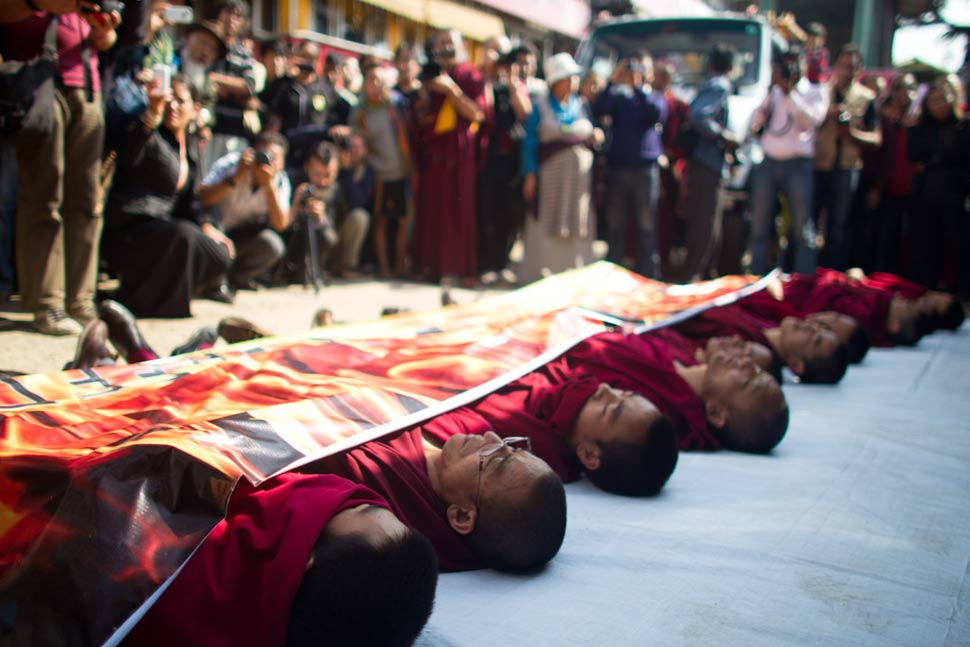From Wiki
http://en.wikipedia.org/wiki/Tibetan_diaspora
om Wikipedia, the free encyclopedia
Jump to: navigation, search
The Tibetan diaspora is a term used to refer to the communities of Tibetan people living outside Tibet. Tibetan emigration happened in two waves: one in 1959 following the 14th Dalai Lama's self-exile in India, and the other in the 1980s when Tibet was opened to trade and tourism. The third wave continues from 1996 to today. Not all emigration from Tibet is permanent; today some parents in Tibet send their children to communities in the diaspora to receive a traditional Tibetan education. In the 2009 census, Tibetans in exile registered are about 128,000, with the most numerous part of the community living in India, Nepal, and Bhutan.[1] However, in 2005 and 2009 an estimation at up to 150,000 was given.
Origins and numbers
The Central Tibetan Administration (CTA) provides a Green Book - a kind of Tibetan identity certificate - to Tibetan refugees. Based on a CTA survey from 2009, 127,935 Tibetans were registered in the diaspora: in India 94,203; in Nepal 13,514; in Bhutan 1,298; and in rest of the world 18,920.[1] However, their number is estimated at up to 150,000, as mentioned by both Edward J. Mills et al. in 2005 and by the 14th Dalai Lama in 2009.[2][3]
The larger of the other communities are in the USA, Canada, the United Kingdom, Switzerland, Norway, France, Taiwan and Australia.[4][not in citation given]
[edit] First wave
During the 1959 Tibetan uprising, the 14th Dalai Lama and some of his government fled to India. From 1959 to 1960, about 80,000 Tibetans followed the Dalai Lama to India through the Himalayas.[5] Continued flights, estimated in the numbers of 1,000 to 2,500 a year, increased these numbers to 100,000.[6] The movement of refugees during this time is sometimes referred to as an "exodus",[7][8] as in a United Nations General Assembly resolution in 1961 that asserted that the presence of Tibetan refugees in neighboring countries was "evidence" of rights abuses in Tibet.[9]
[edit] Second wave
After the opening of Tibet in the 1980s to trade and tourism, a second Tibetan wave of exile took place due to increasing political repression. From 1986 to 1996, 25,000 Tibetans joined and increased by 18% their exiled community in India. This movement of refugees during this second wave is sometimes referred to as a "second exodus".[10]
According to a US cable put out by WikiLeaks, from 1980 to November 2009, 87,096 Tibetans arrived in India and registered at the Dharamsala reception center, whereas 46,620 returned to Tibet after a pilgrimage in India. Most of those staying are children to attend Tibetan Children's Villages school.[11]
[edit] Present emigration
A 2008 documentary directed by Richard Martini claimed that 3,000–4,500 Tibetans arrive at Dharamsala every year.[12] Most new immigrants are children who are sent to Tibetan cultural schools, sometimes with the tacit approval of the Chinese government. Many political activists, including monks, have also crossed over through Nepal to India. Significant cultural gaps exist between recent Tibetan emigrants (gsar 'byor pa; "newcomer") and Indian-born Tibetans. The more established Tibetans in diaspora reject recent immigrant Tibetans who watch watch Chinese, sing Chinese music, and can speak Mandarin, who are than alienated from the exile community. Newcomers express frustration that the government-in-exile only wants to hear only "bad things" about Chinese rule in Tibet, and a lack of economic opportunity in Dharamsala.[13]
